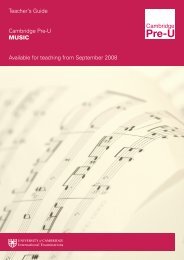Cambridge Pre-U Syllabus - Cambridge International Examinations
Cambridge Pre-U Syllabus - Cambridge International Examinations
Cambridge Pre-U Syllabus - Cambridge International Examinations
Create successful ePaper yourself
Turn your PDF publications into a flip-book with our unique Google optimized e-Paper software.
26<br />
2.3 The evolution of life<br />
Content<br />
Selection and changes in allele frequency<br />
Speciation<br />
Aspects of evolution<br />
<strong>Cambridge</strong> <strong>Pre</strong>-U Draft<br />
Learning outcomes<br />
Candidates should be able to:<br />
a) outline Darwin’s and Wallace’s observations and conclusions<br />
b) describe evolutionary patterns of divergence and adaptive radiation including the Galapagos finches as<br />
an example<br />
c) outline the mechanisms leading to evolutionary changes in allele frequency in populations including: the<br />
role of mutation in producing genetic variation; how such variations might enable organisms with<br />
particular alleles and particular phenotypes to survive better and reproduce more frequently<br />
d) describe and explain directional, stabilising and disruptive selection<br />
e) discuss what effect increased environmental stress resulting from global climate change (with increased<br />
temperatures and more extreme weather conditions) might have on habitats and organisms and thus on<br />
food chains and niche occupation<br />
f) compare current and background rates of extinction with those during past mass extinctions (students<br />
should be aware that these figures are not agreed by all scientists)<br />
g) explain the role of isolation in allopatric speciation (with particular reference to evidence from ‘ring<br />
species’) and sympatric speciation (in relation to behavioural isolation in African cichlids)<br />
h) explain the causes and effects of bacterial genetic resistance to antibiotics<br />
Practical learning outcomes<br />
Candidates should be able to:<br />
i) investigate the relationship between aspects of the environment and features of species such as banded<br />
snails (Cepaea spp.)

















